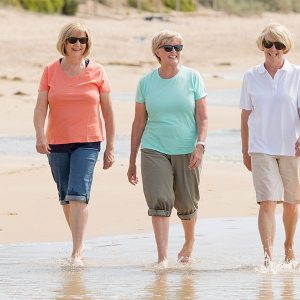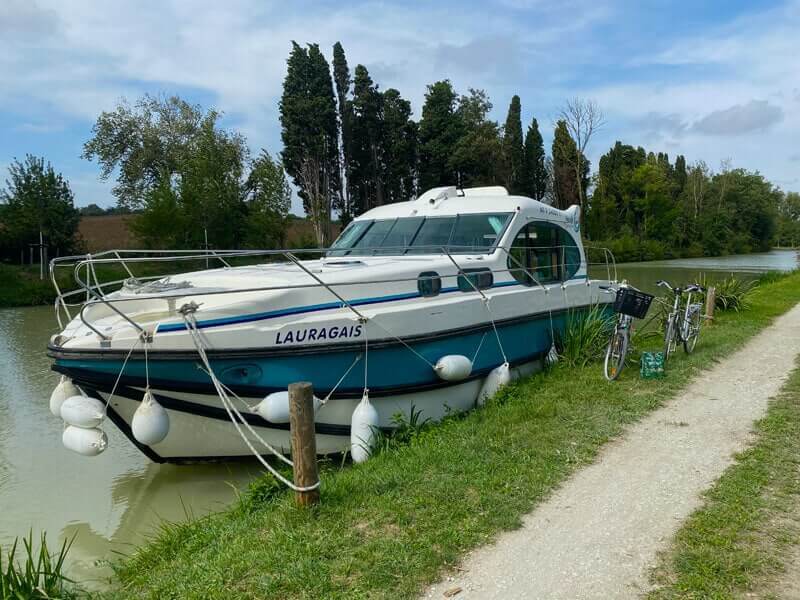 “Believe me, my young friend, there is nothing – absolutely nothing – half so much worth doing as simply messing about in boats”. So said Kenneth Graham in The Wind in the Willows and after a delightful week spent messing about in a rather lovely boat on the Canal du Midi, deep in the South of France, we couldn’t disagree. Though we’d had our moments!
“Believe me, my young friend, there is nothing – absolutely nothing – half so much worth doing as simply messing about in boats”. So said Kenneth Graham in The Wind in the Willows and after a delightful week spent messing about in a rather lovely boat on the Canal du Midi, deep in the South of France, we couldn’t disagree. Though we’d had our moments!
This was our second trip with France’s most popular boating specialist, Nicols, having enjoyed pottering down the river Saône before, so we reckoned we knew what to expect – or did we?
The boat that everyone wanted to be on
Our Estivale Quattro S boat was as squeaky-clean, sleek, well-laid-out and well-equipped as before. The stern deck, spacious living area and kitchen, with its full-size fridge-freezer were all conveniently on one level, while a step-down led to the full-height master cabin, en suite with an enclosed shower (no soggy shower curtains here), and the second bedroom, which we used as a dressing area and for luggage storage.
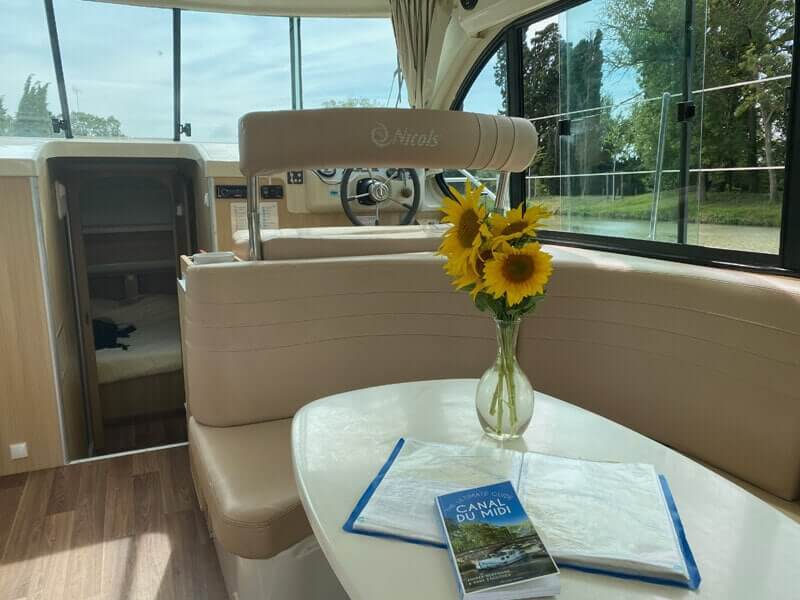 With just two of us aboard, we loved having so much space to move around in, with the pièce de resistance being the flying bridge, an outside upper deck from which you can steer the boat, so two of us could sit side-by-side in the sunshine and watch as the glorious canal-side scenery scrolled by. And among all the various vessels on the canal, it did seem to be our boat that was attracting a good few admiring glances.
With just two of us aboard, we loved having so much space to move around in, with the pièce de resistance being the flying bridge, an outside upper deck from which you can steer the boat, so two of us could sit side-by-side in the sunshine and watch as the glorious canal-side scenery scrolled by. And among all the various vessels on the canal, it did seem to be our boat that was attracting a good few admiring glances.
A useful extra feature
The one thing that was different this time round was that the boat came with bow-thrusters. These are like little side propulsion units at the front of the boat that add extra manoeuvrability. And we soon appreciated why this time they were included. Because we’d chosen a section of the Canal du Midi that entailed passing through 56 locks in just six days.
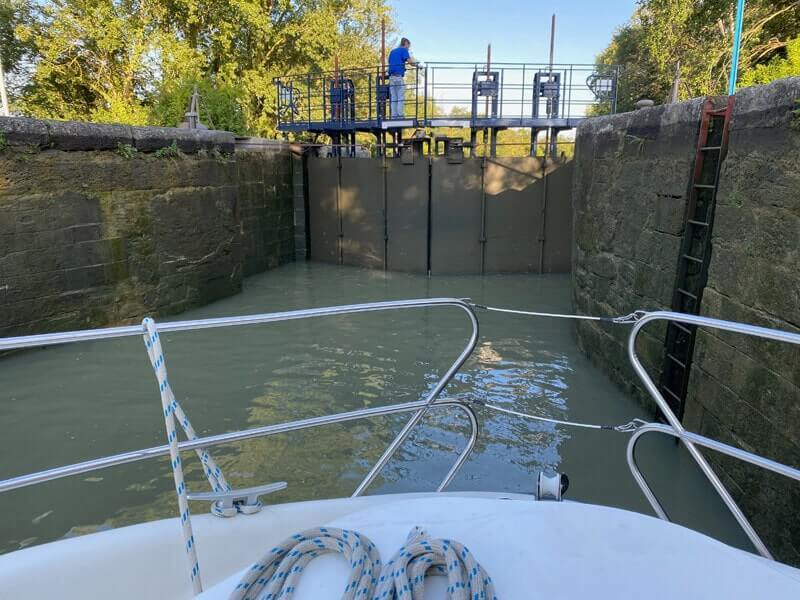 It had all made sense when we booked. My other half is not the sort who enjoys sitting on a beach, but he’d loved getting to grips with the infrequent locks on our previous boat trip. But it was only when we looked through the detailed maps and notes helpfully provided by Nicols on the boat itself that the reality began to sink in.
It had all made sense when we booked. My other half is not the sort who enjoys sitting on a beach, but he’d loved getting to grips with the infrequent locks on our previous boat trip. But it was only when we looked through the detailed maps and notes helpfully provided by Nicols on the boat itself that the reality began to sink in.
Chocablock of locks
56 locks is quite a lot. But there really is plenty of time and no need to rush. And once we’d got into the rhythm of it, we did rather enjoy ticking off all the locks we passed through, some in ‘flights’ of three or four at a time so you end up about 40 feet below where you started. And hubbie really took to the bow-thruster gizmos that could turn the boat on a sixpence and made gliding into place in the locks a cinch (not that he’d admit it!).
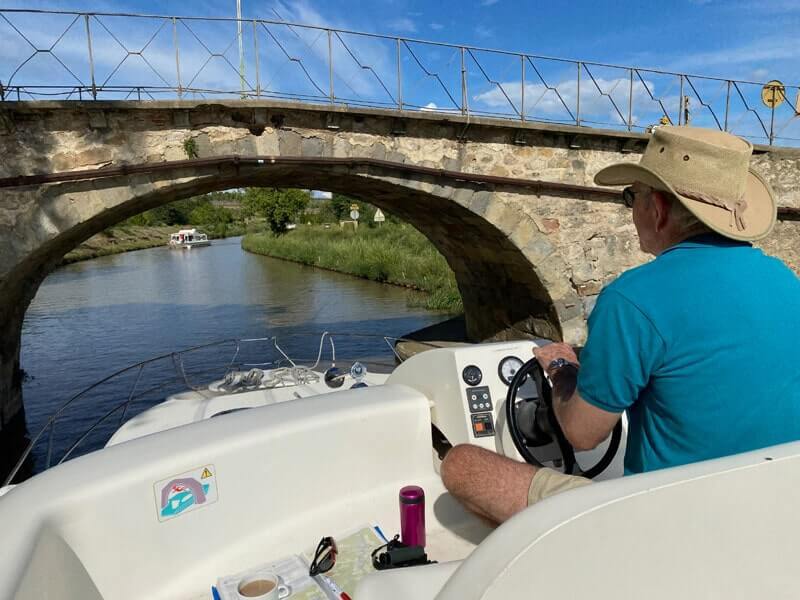 We soon started looking forward to each new lock. Most could take up to four boats at the same time, and with helpful lockkeepers – as well as the other boat crews – to hand to help your boat get loosely tied-up, conversations started up easily and we met some lovely people en route. The camaraderie of boating crosses international boundaries and there was much sharing of tips on lunch stops, good restaurants and where to find the nearest supermarket. It was all surprisingly sociable!
We soon started looking forward to each new lock. Most could take up to four boats at the same time, and with helpful lockkeepers – as well as the other boat crews – to hand to help your boat get loosely tied-up, conversations started up easily and we met some lovely people en route. The camaraderie of boating crosses international boundaries and there was much sharing of tips on lunch stops, good restaurants and where to find the nearest supermarket. It was all surprisingly sociable!
Help is on hand if needed
The locks really aren’t difficult to master and the Nicols staff at your departure point are patient and helpful, taking you out for a trial run to make sure you feel confident before you set forth on your own. And as well as a bit of Franglais, we found native-English being spoken by the staff at both the start and end bases, which was an extra reassurance.
You don’t need a licence to drive a Nicols boat, nor do you need any previous boating experience. But if you’ve never been on a boat before, especially if there are only two of you, you might prefer the 52 km of the Canal du Midi you can travel along without encountering a single lock.
Lock-down, not lock-up
The other thing to bear in mind is that it’s much easier to go downstream than up. Going downstream means that when you enter a lock, the chamber is already full of water, which then drains away, slowly lowering your boat until you are ready to drive out of the gates into the lower section of the Canal. This way round means that when you enter the chamber, it’s easy to loop your ropes around the bollards at its edge, as you are on the same level. If you are travelling up-stream, you’ll start in an empty chamber and may need a bit of help to throw your ropes up a dozen feet to loop around the bollards at the top of the chamber. Not impossible – just not as easy!
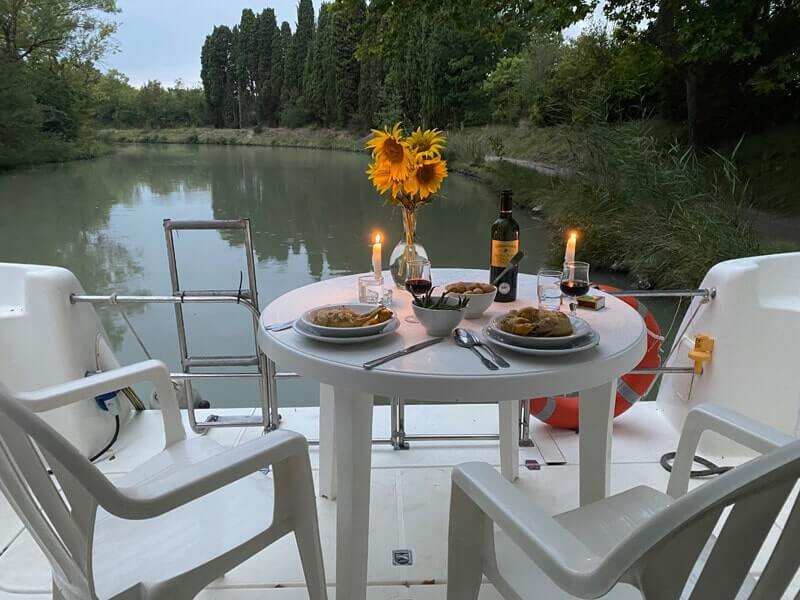 The other thing to bear in mind is that, in the finest French tradition, the locks close every day between 12 and 1pm for lunch. This all contributes to the sense of slow-living that boating entails. Travelling at a little over walking pace, boating is about relaxation, not revving it up. And while there are plenty of welcoming marinas where you can moor at night, we preferred ‘nature moorings’, that is, banging in a large tent peg by the side of the canal and tying up somewhere scenic for the night. Watching the sun go down over a bend in the canal, glass in hand, as the owls begin to hoot, and otters and coypu nose around the shallows, made for some delightful evenings.
The other thing to bear in mind is that, in the finest French tradition, the locks close every day between 12 and 1pm for lunch. This all contributes to the sense of slow-living that boating entails. Travelling at a little over walking pace, boating is about relaxation, not revving it up. And while there are plenty of welcoming marinas where you can moor at night, we preferred ‘nature moorings’, that is, banging in a large tent peg by the side of the canal and tying up somewhere scenic for the night. Watching the sun go down over a bend in the canal, glass in hand, as the owls begin to hoot, and otters and coypu nose around the shallows, made for some delightful evenings.
Sunflowers, sunshine and scenery
We also enjoyed the change in the landscape as we travelled from sunflower-country into the winelands. To see the sunflowers in all their golden glory, you’d need to holiday in July or August but even in September, a few sunny yellow faces still cheered the fields on either side of the Canal.
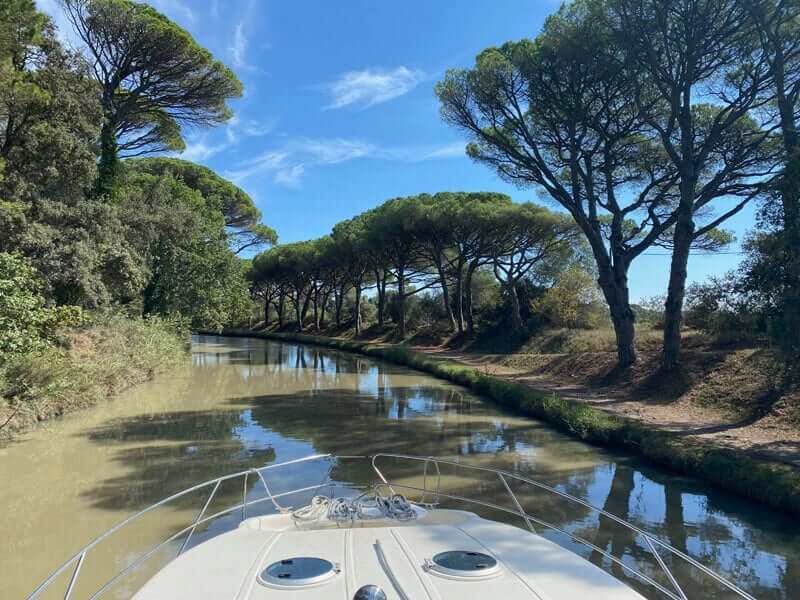 The medieval walled city of Carcassonne marked our half-way point, and we were glad of the two Nicols bikes that we’d safely stowed on the upper deck. We’d overnighted a mile or so away from the busyness of the city, and the ride along the towpath in the morning sunshine made for a refreshing change. But you can moor right in the midst of this compact city and walk from the quayside. A fairytale castle of turrets and conical roofs dominates the skyline – it’s said to have inspired Disney’s Sleeping Beauty castle and ‘Robin Hood – Prince of Thieves’ was shot here.
The medieval walled city of Carcassonne marked our half-way point, and we were glad of the two Nicols bikes that we’d safely stowed on the upper deck. We’d overnighted a mile or so away from the busyness of the city, and the ride along the towpath in the morning sunshine made for a refreshing change. But you can moor right in the midst of this compact city and walk from the quayside. A fairytale castle of turrets and conical roofs dominates the skyline – it’s said to have inspired Disney’s Sleeping Beauty castle and ‘Robin Hood – Prince of Thieves’ was shot here.
Beyond Carcassonne, the countryside grew prettier still, with the fields filling with the vines of the Minervois winelands. Further on, those muscular Scots pines typical of France lined the route. And a striking image that has stayed with us was rounding a bend to find a road running right alongside the canal, with cars driving parallel to our boat, almost within touching distance.
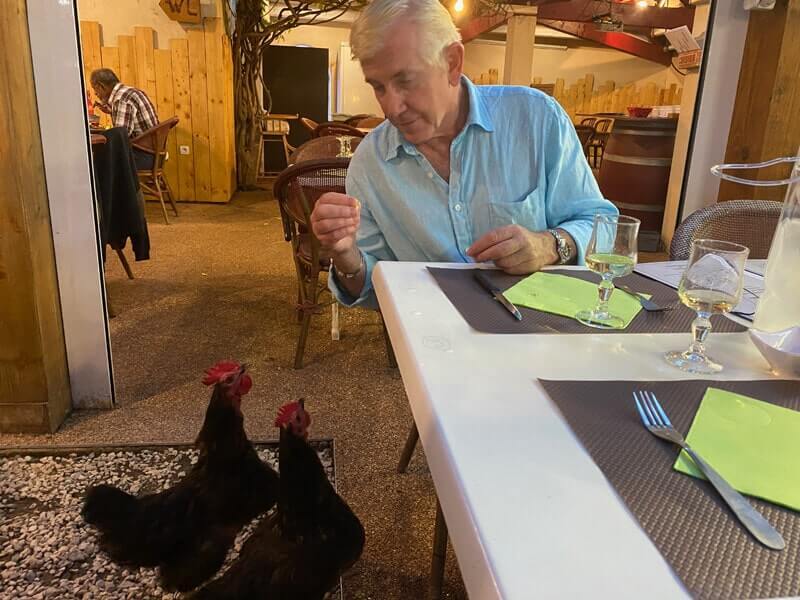 Pretty villages abound in this region: Paraza is a particularly lovely huddle of stone-built houses rising to a 17th century castle, with an open air, waterfront restaurant where fairylights twinkle under the trees and pet hens beg for scraps around your feet (reassuringly, chicken isn’t on the menu).
Pretty villages abound in this region: Paraza is a particularly lovely huddle of stone-built houses rising to a 17th century castle, with an open air, waterfront restaurant where fairylights twinkle under the trees and pet hens beg for scraps around your feet (reassuringly, chicken isn’t on the menu).
And then all too soon, we were coasting into Le Somail, our final stop, all tumbling geraniums, prettily painted barges and a honey-stone bridge arching over the water.
Those 56 locks had unlocked a world of sunflower fields, sunbaked villages and boatfuls of bonhomie which we were sorry to leave behind.
Boating tips
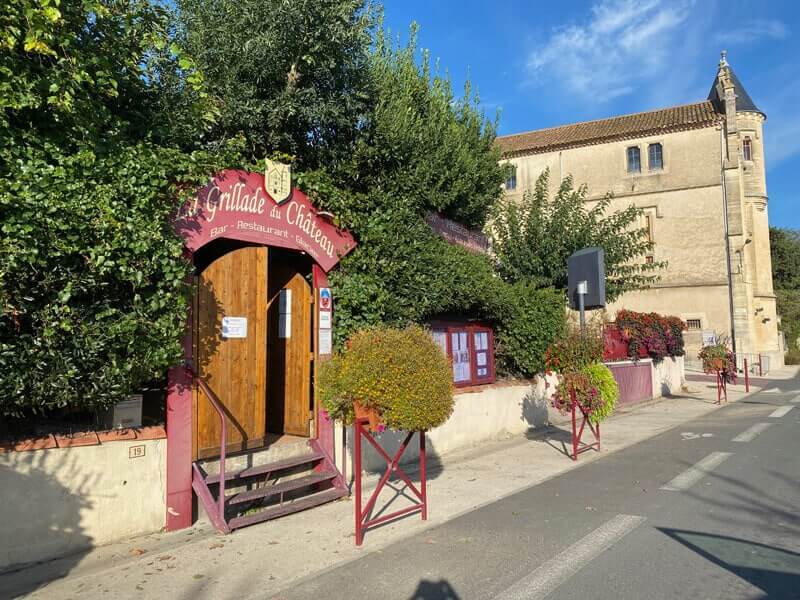 Bring gloves to save your hands when handling the ropes. And binoculars for checking if the approaching lock gates are already open, as well as spotting the occasional kingfisher.
Bring gloves to save your hands when handling the ropes. And binoculars for checking if the approaching lock gates are already open, as well as spotting the occasional kingfisher.
We drove to the Nicols base at Port Lauragais, which meant stocking up on what we needed for the week was easy. But there are supermarkets in the villages along the way, all clearly marked on the maps you carry on board.
We brought washing-up liquid and soap – there is an eco-friendly welcome pack of these but in small quantities. Also bring medium-sized bin liners and extra loo roll, plus fly spray and insect repellent. We found cling film was useful for the delicious French cheese and lining the bottom of the oven with kitchen foil saved having to clean it.
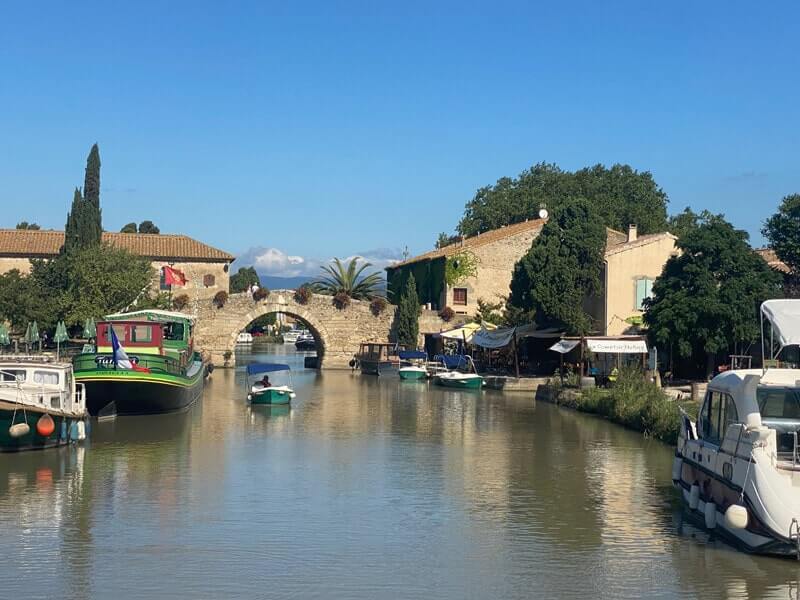 Which is better boating, canals or rivers? Rivers tend to have clearer water, are wider and have fewer locks. The Canal du Midi was the colour of tea, being churned up by so many propellers, but only being about four boat-widths across, the landscape on either side feels much closer. If, like us, you rather enjoy the sociability of passing through the locks with other boating folk, canals may be the perfect choice for you.
Which is better boating, canals or rivers? Rivers tend to have clearer water, are wider and have fewer locks. The Canal du Midi was the colour of tea, being churned up by so many propellers, but only being about four boat-widths across, the landscape on either side feels much closer. If, like us, you rather enjoy the sociability of passing through the locks with other boating folk, canals may be the perfect choice for you.
More information
Nicols offers river and canal holidays aboard self-drive cruisers suitable for parties of between 2-10 people. Boat hire prices start from 349 Euros for a 2-night short break or 698 Euros for a one-week trip.
A two-cabin Estivale Quattro boat for a one-week trip between Port Lauragais and Le Somail in mid-September 2022 would cost about 2,100 Euros for the hire of the boat. Fuel is charged as used – ours came to about 350 Euros.
Nicols has 18 different bases in popular regions such as Alsace, Burgundy, the Loire Valley, Brittany, the Camargue plus bases in Germany, Portugal, the Netherlands and Hungary.
For more information visit www.boat-renting-nicols.co.uk or call 02392 401320.




